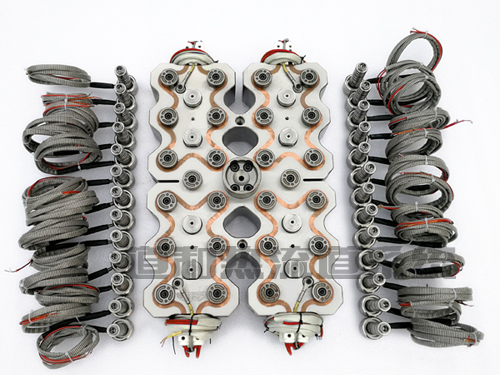A professional manufacturer that develops and produces high-quality hot runner systems including: Various hot runners and its accessories such as hot runner, hot sprue, temperature control box.
+86 135-5977-1931

在In the hot runner system, it is well known that the temperature control box is an indispensable part of the temperature control system, and the thermocouple plays a pivotal role in the temperature control system. Here is a brief introduction to the principle analysis of temperature measurement through thermocouples in the hot runner.

The temperature measurement principle of the plug-in temperature control card is that the thermocouple temperature measurement is composed of two different components of the material conductor closed loop, when there is a temperature gradient at both ends, there will be current through the loop, at this time there is an electromotive force between the two ends - thermoelectric motive force, the plug-in temperature control card processing chip will capture this signal, the electromotive force into the measured temperature.
electromotive force is divided into positive and negative poles, so in our temperature control box system, the temperature sensing line must be divided into positive and negative poles, note that in the process of wiring, the temperature sensing line must not be connected inversely, otherwise it will lead to the heating system can not work normally. Our temperature control card will have Chinese alarm characters (Chinese LCD card) for temperature sensing wire connection and accompanied by high decibel buzzer alarm to remind users to check the connection.
When the thermocouple measures the temperature, it is required that the temperature of the cold end (the measurement end is the hot end, and the end connected to the measurement circuit through the lead is called the cold end) remain unchanged, and the size of the thermoelectric potential is proportional to the measurement temperature. If the temperature of the cold end (ambient) changes during measurement, the accuracy of measurement will be seriously affected. At the cold end, some measures are taken to compensate the influence caused by the temperature change of the cold end, which is called the cold end compensation of the thermocouple.
Thermocouple is actually an energy converter, which converts heat energy into electricity, and measures temperature with the generated thermoelectric potential, and for the thermoelectric potential of the thermocouple, pay attention to the following two points:
(1) The thermoelectric potential of a thermocouple is the difference between the temperature functions at both ends of the working end of the thermocouple, not the function of the temperature difference between the cold end and the working end of the thermocouple;
(2) The size of the thermoelectric potential generated by the thermocouple, when the material of the thermocouple is uniform, has no relationship with the length and diameter of the thermocouple, only with the composition of the thermocouple material and the temperature difference between the two ends.
Our commonly used thermocouples can be divided into two categories: standard thermocouples and non-standard thermocouples. The so-called standard thermocouple refers to the thermocouple that the national standard stipulates the relationship between its thermoelectric potential and temperature, the allowable error, and has a unified standard indexing meter, non-standardized thermocouples in the range of use or order of magnitude are less than standardized thermocouples, generally there is no unified indexing meter, mainly used for some special occasions measurement.
Standardized thermocouples From January 1, 1988, thermocouples and thermal resistors are all produced according to IEC international standards, and S, B, E, K, R, J, T seven standardized thermocouples are designated as unified design thermocouples in China.
S Platinum rhodium alloy (Rhodium content 10%) Pure platinum 0-1600
R Platinum rhodium alloy (Rhodium content 13%) Pure platinum 0-1600
B Platinum rhodium alloy (Rhodium content 30%) Platinum rhodium alloy (Rhodium content 6%) 0-1800
K Chromium-nickel silicon 0-1300
T pure copper Copper nickel 0-350
J Iron copper nickel 0-+500
N Chromium silicon nickel silicon 0-+800
> E Nichrome Copper Nickel 0-600
We choose thermocouples according to the use of temperature range, the required accuracy, the performance of the measurement object, response time and economic benefits and other comprehensive considerations, for our hot runner industry, we use the most is the J-type and K-type thermocouple, its advantages are cheap linearity, high thermoelectric motive force, high sensitivity, and so on. Good stability and uniformity. The plug-in temperature control card can also switch between type J and type K sensor types to match the corresponding thermocouple. This feature is quite economical and labor-saving for users.
About Us
Introduction to Company Application Cases Analysis of modal flow Honor & Qualifications Corporate ImageProducts of hot runner
Multicavity hot runner system Hot runner system Hot sprue of hot runner More productsNews Center
Company News Industry Information Frequently Asked Questions+86 135-5977-1931
Monday to Sunday 8:30-21:30
(Welcome to inquire by phone)
 WeChat
WeChat